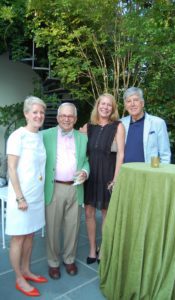Tree Lovers and Killers in Georgetown
By • September 11, 2017 0 1930

The white-and-gold tent sparkled with tiny lights and vine-wrapped candelabras Sunday night, Sept. 10, as a band played swing and jazz. The crowd of more than 200 elegantly dressed Georgetowners sipped wine and ate hors d’oeuvres — shrimp, oysters on the half shell, lamb sausages and tiny bocaditas — beside the azure blue swimming pool in the garden of the R Street home of Calvin and Jane Cafritz.
It was the annual gathering of Trees for Georgetown, a committee of the Citizens Association of Georgetown formed in 1989. Partygoers were there to show their love and support of trees; the group’s mission is to plant and maintain the trees that line the residential streets of Georgetown.
“Street trees endure terrific stress,” said Betsy Emes, who has chaired Trees for Georgetown for the past 12 years and served as a volunteer for 14 years before that. “We ask that Georgetowners care about them and take care of them.”
In 2015-16, 22 newly planted trees were lost, according to Trees for Georgetown. The organization and arborists decided to dig up, transplant and plant some 58 new trees last spring.
“Most of the trees two years ago were lost to inclement weather,” Emes said. “But that’s not the main killer of trees in Georgetown. There are two top killers of Georgetown’s street trees. The first is they are not getting enough water. They need water every few days if it doesn’t rain. Residents need to do it.
“Water them with a hose. If your hose isn’t long enough, buy a longer one. If you don’t have a hose bib at your house, use a neighbor’s. If it’s not your tree directly in front of your house, if it’s old established, wilting or new, adopt it. Share it with a neighbor or two. If you’re going away for a while, ask someone you know to water them. Do something!” It was clear why the soft-spoken Emes has been chair for 12 years.
The second big killer of street trees, according to Emes, is pyramid fertilizing. “It’s quick, it’s easy. Cities like Boston do it all the time. Pull up to the street tree with a truck full of fertilizer and dump a pyramid of it around the tree, then leave. Easy! But it can kill a tree at the bottom of the buried trunk,” Emes said fervently. “When you see a pyramid of fertilizer, spread it around.”
Recently, the threat to Georgetown trees by leaking gas from broken underground gas pipes was analyzed by an expert from Boston. He found a spike in leaks on many Georgetown streets. But Emes was skeptical. “A gas leak will kill a tree almost instantly,” she claimed. “It won’t just wilt slowly. In the past, when we have found gas leaks near our street trees, we call the gas company and they have always responded immediately.
“We had also thought that cars parking on streets next to trees would impact the earth so much around the roots that it would kill the tree,” Emes continued. “But we found to our surprise that most trees do not grow their roots under streets. Yes, it’s strange. It’s a bit of a mystery.”
One of the goals of Trees for Georgetown is to increase the diversity of tree species in the area. In last year’s replant, species included hackberry, London plane, “Happidaze” and “Worplesdon” sweet gum, Carolina silverbell, disease-resistant American elm, overcup oak, swamp white oak, bur oak, willow oak and two new introductions: bald cypress and chinquapin oak.
As always, regulation wrought-iron fences were installed around each tree. Letters were hand-delivered to homeowners residing directly behind each new tree, as well as to neighbors on each side, with instructions for their care.

At their R Street home, Jane and Calvin Cafritz flank Betsy Emes, chair of the Trees for Georgetown, a program of the Citizens Association of Georgetown. Photo by Robert Devaney.

Betsy Emes, chair of Trees for Georgetown, with Bob Laycock, treasurer of the Citizens Association of Georgetown, with event chairs Christi Cline and Frank Randolph. Photo by Robert Devaney.

